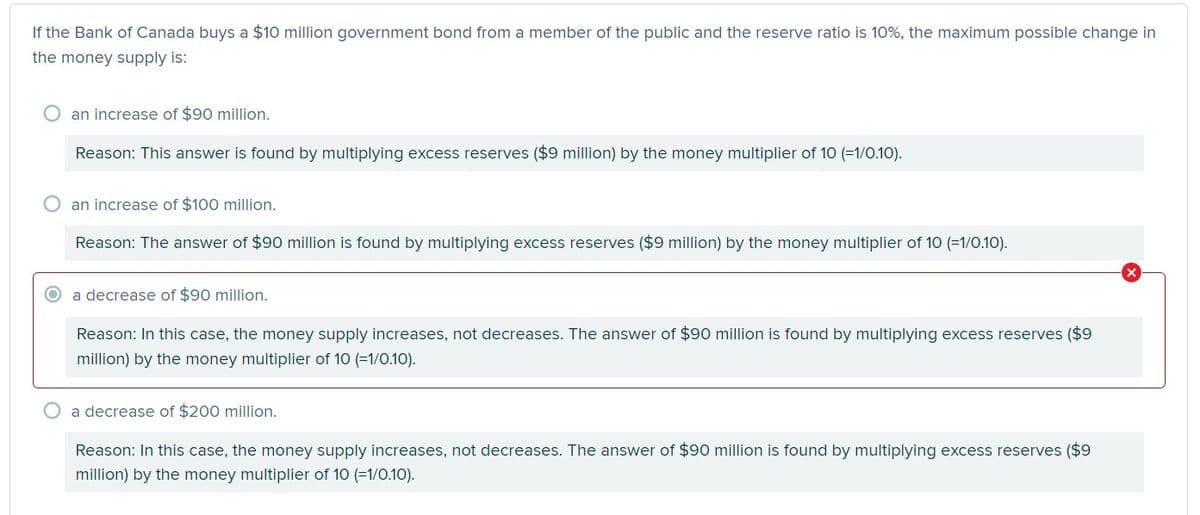If the Bank of Canada buys a $10 million government bond from a member of the public and the reserve ratio is 10%, the maximum possible change in the money supply is:
If the Bank of Canada buys a $10 million government bond from a member of the public and the reserve ratio is 10%, the maximum possible change in the money supply is:
Brief Principles of Macroeconomics (MindTap Course List)
8th Edition
ISBN:9781337091985
Author:N. Gregory Mankiw
Publisher:N. Gregory Mankiw
Chapter11: The Monetary System
Section: Chapter Questions
Problem 2PA
Related questions
Question
reserve ratio= desired reserves/ deposits
money multiplier= change in excess x money multiplier
excess resrves: cash resseves- desired reserves
so money multiplier = 1/10%= 10
wouldn't the answer be 10x 10 million?. I'm so confused on where the 9 million came from. I think it's 10 million - 10%. Please help me explain this question.

Transcribed Image Text:If the Bank of Canada buys a $10 million government bond from a member of the public and the reserve ratio is 10%, the maximum possible change in
the money supply is:
O an increase of $90 million.
Reason: This answer is found by multiplying excess reserves ($9 million) by the money multiplier of 10 (=1/0.10).
O an increase of $100 million.
Reason: The answer of $90 million is found by multiplying excess reserves ($9 million) by the money multiplier of 10 (=1/0.10).
a decrease of $90 million.
Reason: In this case, the money supply increases, not decreases. The answer of $90 million is found by multiplying excess reserves ($9
million) by the money multiplier of 10 (=1/0.10).
a decrease of $200 million.
Reason: In this case, the money supply increases, not decreases. The answer of $90 million is found by multiplying excess reserves ($9
million) by the money multiplier of 10 (=1/0.10).
Expert Solution
This question has been solved!
Explore an expertly crafted, step-by-step solution for a thorough understanding of key concepts.
Step by step
Solved in 2 steps

Knowledge Booster
Learn more about
Need a deep-dive on the concept behind this application? Look no further. Learn more about this topic, economics and related others by exploring similar questions and additional content below.Recommended textbooks for you

Brief Principles of Macroeconomics (MindTap Cours…
Economics
ISBN:
9781337091985
Author:
N. Gregory Mankiw
Publisher:
Cengage Learning

Principles of Economics (MindTap Course List)
Economics
ISBN:
9781305585126
Author:
N. Gregory Mankiw
Publisher:
Cengage Learning

Principles of Macroeconomics (MindTap Course List)
Economics
ISBN:
9781305971509
Author:
N. Gregory Mankiw
Publisher:
Cengage Learning

Brief Principles of Macroeconomics (MindTap Cours…
Economics
ISBN:
9781337091985
Author:
N. Gregory Mankiw
Publisher:
Cengage Learning

Principles of Economics (MindTap Course List)
Economics
ISBN:
9781305585126
Author:
N. Gregory Mankiw
Publisher:
Cengage Learning

Principles of Macroeconomics (MindTap Course List)
Economics
ISBN:
9781305971509
Author:
N. Gregory Mankiw
Publisher:
Cengage Learning

Essentials of Economics (MindTap Course List)
Economics
ISBN:
9781337091992
Author:
N. Gregory Mankiw
Publisher:
Cengage Learning


Economics: Private and Public Choice (MindTap Cou…
Economics
ISBN:
9781305506725
Author:
James D. Gwartney, Richard L. Stroup, Russell S. Sobel, David A. Macpherson
Publisher:
Cengage Learning